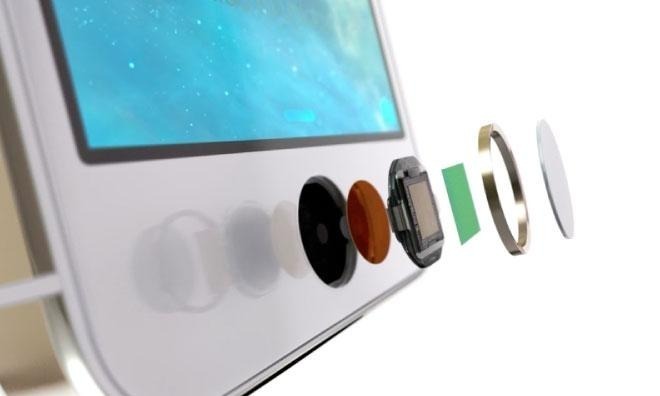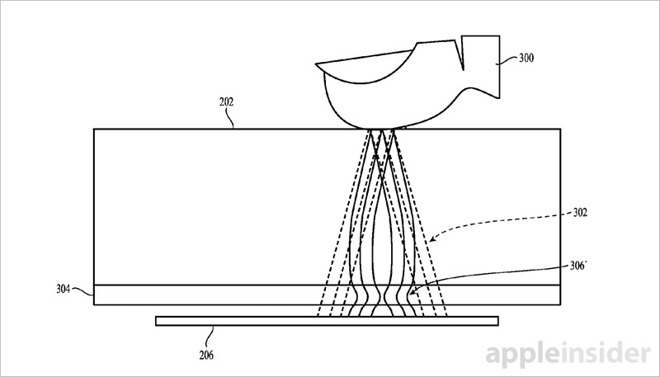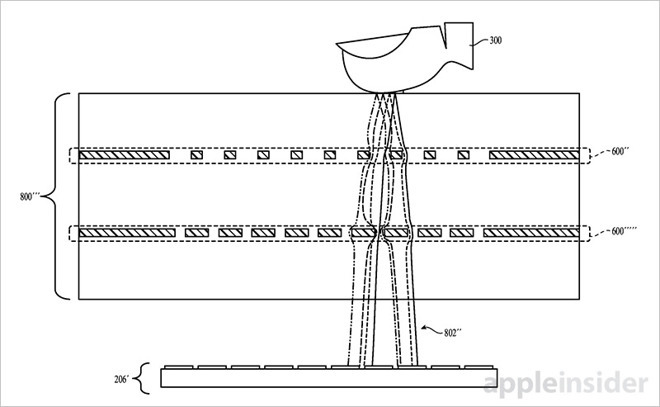There's a lot of talk about Apple's shift to a new screen technology with the "iPhone 8," but fewer conversations about how it will all work — AppleInsider explains what changes Apple will likely need to make to implement the technology, while retaining Touch ID on the front of the rumored edge-to-edge screen on the device.
A rumored shift to an OLED screen in the "iPhone 8" changes the game — not just for battery life, but for related technologies. Apple has had a great deal of success with the best-in-class fingerprint reader technology that it has used since the iPhone 5s, but unless it's moved to the back of the phone, the underlying sensing technology needs to change.
As it stands with the iPhone 5s through the iPhone 7, the Touch ID technology developed by AuthenTec senses the presence of a finger with a detection ring which switches on the sensor when it detects a digit. The sensor itself is clad in a thin sapphire crystal, and uses a complimentary metal oxide semiconductor capacitive touch sensor to detect the fingerprint's whorls and ridges with 500 pixels per inch resolution.
The captured fingerprint is then passed to the Secure Enclave and compared to stored data local to the phone. Should the mathematical models match, the phone is unlocked.
There are two major revisions of Touch ID, with the only real difference being sensing speed in more recent version on the iPhone 6 and iPhone 7 families.
So where's the problem?
The problem lies with the difference in thickness between the sapphire lens and the sensor. The sensor itself is 170 microns thick, with the sapphire lens not that much thicker.
While an OLED screen assembly is thinner than that of a comparative LCD display, the glass cover is about the same thickness between the technologies. At just less than 1 millimeter thick, the screen glass is over five times the thickness of the sapphire lens on the existing Touch ID sensor on the iPhone 7.
With fingerprint sensors used in Touch ID, as separation between the contact surface where a user places their finger and the capacitive sensing array increases, there is a corresponding blurring of the finger's electric field captured by the Touch ID sensor. In the existing Touch ID implementation, the lens is sufficiently thin that any distortion, or aberration, is minimal.
When a sensor is placed behind a thicker lens, in the case of the "iPhone 8," behind the screen glass itself, the inevitable blurring without some form of correction can lead to degraded fingerprint image resolutions and decreased recognition accuracy.
Math can be used to determine exactly how much distortion would be introduced with thicker glass — but it is extremely complex and to figure it out precisely would require more data about the optics of the sapphire Touch ID cover than is currently known. However, roughly speaking, the aberrations induced between Touch ID now, and if it was embedded behind much thicker screen glass would increase between 5 and 15 times what is expected now.
If Apple compensated in software for that and allowed for more fingerprint variation between what is stored and what is sensed, it would make Touch ID much less secure. This would likely be unsatisfactory for the banking industry, and would impact Apple Pay.
However, Apple has a patent for a touch sensor using an array of electrostatic lenses. By using the lenses in between a designated touch area and the sensor behind the thicker glass, the electric field associated with a user's finger can be presented undistorted — or less distorted — to a sensor embedded in the glass.
Apple has to perfect this, before the Touch ID can be embedded under glass. Perfection must extend to manufacture of the sensor, as well.
Nobody said that this would be easy
Optics on a macro scale in a telescope aren't quite the same as on a micro scale in Touch ID — and make no mistake, a microscopic scale is what we're talking about with the iPhone's implementation of Touch ID. Differences in microns can make all the difference between accuracy and security of the system, or one that doesn't work well at all.
Apple says that the probability of matching a Secure Enclave stored fingerprint is 1 in 50,000 for one enrolled finger — and this is where it needs to stay, with no slop making it easier to unlock or spoof with a fake finger gleaned from a fingerprint left someplace else.
There are recent reports suggesting that Touch ID is what may hold up the shipment of the "iPhone 8," but not the reveal. There are more claiming that the sensor may get relocated to the back of the device, but given the flak that the Samsung Galaxy S8 is taking for having done so, that may not be the case either.
The road to Touch ID and a virtual home button under a front screen glass was paved with the solid state button on the iPhone 7 family. The technology is crucial to Apple's services, as it is a key underpinning of Apple Pay — to say nothing of cryptological protection of a user's data living on the phone.
Cook and company don't ship a product until they feel that what they've developed is the best that they can make it, for the widest user base, and as safe as possible. However Touch ID develops on the "iPhone 8" in the next few months for the final shipping version will not deviate from that, perhaps at the expense of not shipping in 2017 at all.
 Mike Wuerthele
Mike Wuerthele









-m.jpg)






 Marko Zivkovic
Marko Zivkovic

 Christine McKee
Christine McKee
 Amber Neely
Amber Neely
 Sponsored Content
Sponsored Content
 Wesley Hilliard
Wesley Hilliard

 William Gallagher
William Gallagher









46 Comments
I see Apple as having a problem if the new phone doesn't ship. I don't mean if it ships a month, or so late, but not ship at all this year. We'll see a big hit in sales, and the stock price. I don't think either is acceptable to Apple, or to us.
what we're hearing, and we don't know if it's true, is that the sensor technology does work, but that production of the sensor is behind schedule, so that not enough would be available at launch. If that's true. It would actually be good news. That is, assuming that yield improves enough over some time period.
i disagree with those who have said that Apple would ship without a touch sensor. That just seems impossible! Too much depends on that sensor, and it's the basis of every mobile initiative Apple has been taking in the past few years. On the back? Well, I sure hope not!
but remember that Samsung failed, with Synaptic, to get their behind the screen sensor working, so that they had to put it on the back at the last minute, with poor results. If Apple gets it done, it will be a major embarrassment for Samsung and Synaptics.
A tenth anniversary special edition iPhone 8 to honor the original iPhone arriving in the eleventh year?
Not happening. Wallet open and ready later this fall.
I won't buy it if the sensor is on the back!! I hope it's not!
I hope they can sort it out. Putting the on the back of the phone would be a non-starter for me. The way I use my phone, how I mount it in my car while driving and using it as my music source, the type of case protection I prefer, etc, mean putting the sensor on the back is just not going to work for me. Id that's what they decide to do, I'll just be keeping my iPhone 7 for the time being.